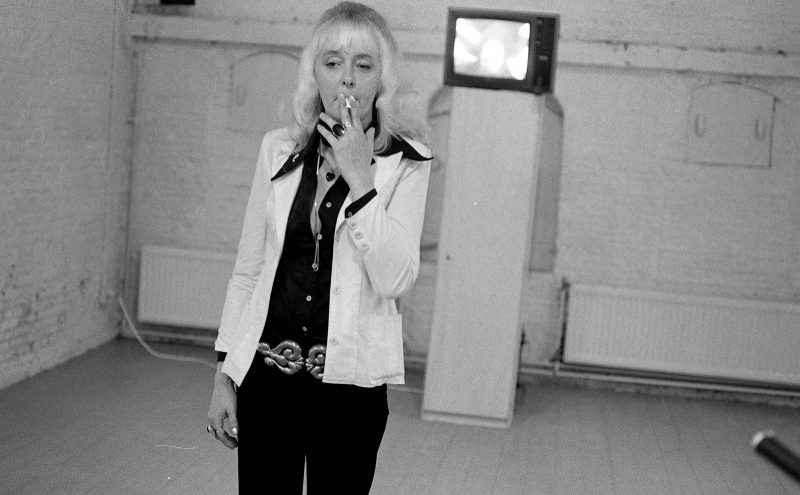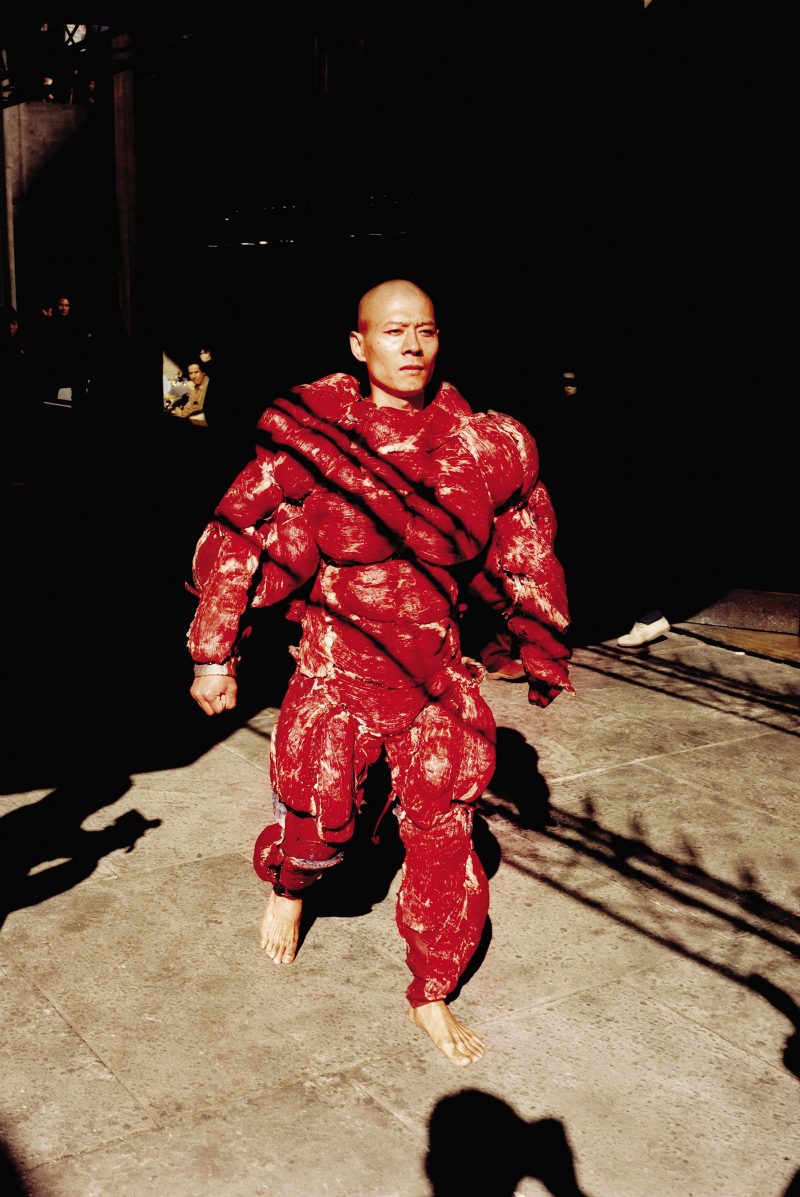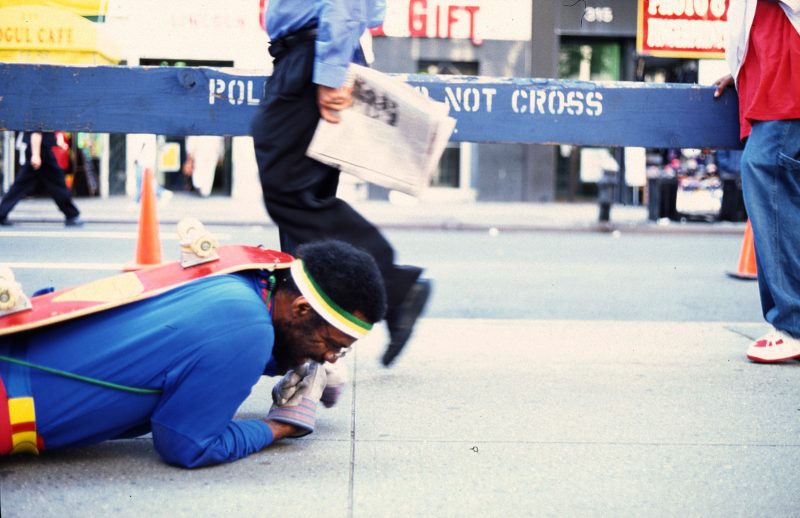


Marina Abramović, (top image) in 1975, trades places with a prostitute from Amsterdam’s red light district for four hours. (A photograph of the prostitute, from the exhibition, appears above.)
Zhang Huan, (middle image) in 2001, wears a full-body costume of raw meat and walks through Manhattan handing out white pigeons to onlookers.
Pope.L, (bottom image) from 2001-2009, crawls on his stomach the length of Broadway – 22 miles – in a cape-less Superman costume.
Wanderers, urban explorers, performers, connoisseurs of the street
These performances are part of the the new, elaborate exhibition at the Barnes, Person of the Crowd: The Contemporary Art of Flânerie, which presents work produced between 1958 and the present, of some 55 artists from 16 countries, and in various media — street photography, painting, performance, sculpture and video. The show also includes a panoply of events, performances, excursions, poster projects, public sculpture, and activities that will take place on the streets of Philadelphia, all designed to engage the crowd in experiences related to the examination and the appreciation of modern urban life. (This review will address only several intriguing works on view in the Barnes’s gallery space.)
The artists, many still working today, are “present-day flâneurs,” that is, strollers, wanderers, urban explorers, performers, connoisseurs of the street, who have addressed critical social, political, economic, and particularly urban issues of our times, including apartheid, consumerism, gentrification, homelessness, gender politics, and racism. Thom Collins, the Barnes’ executive director and president, who curated the show together with Dr. Martha Lucy and guest curator Judith Tannenbaum, describes the artists as detectives, cartographers, scavengers, provocateurs, guerillas and street performers.
“The Man of the Crowd”
The idea of the flâneur comes from Edgar Allen Poe’s 1840 story “The Man of the Crowd,” in which the narrator follows an apparently misanthropic stranger through the streets of London.**
In 1863, in his “The Painter of Modern Life,” Charles Baudelaire described the flâneur as a “passionate [male] spectator” wandering urban streets and documenting his experiences. Eventually, the flâneur came to encompass not only writers and artists, but also their subjects, the participants in urban life, and evolved to include acts of public art making.
Unlikely and compelling works by artists on the streets
In “Venetian Suite” (1980), one of the largest installations in Person of the Crowd, French artist Sophie Calle presents her photographs and journal documenting two weeks during which she secretly trailed a casual male acquaintance, who she called Henri B., from Paris on his holiday in Venice. The photographs are unremarkable, but they serve as road signs to Calle’s long, but wonderfully introspective and haunting narrative, which she composed as she followed Henri B. throughout Venice (including an incident in which their paths crossed), and ultimately back to Paris.
Any urban dweller will be reminded by Calle’s installation of the experience of familiar faces, life stories unknown, and the impossible yearning to discover and connect.
Over a period of five years (2008 – 2013), and in five different cities, and on multiple routes in those cities leading from her home to her studio, American artist Brett Day Windham picked up from the ground one object per walk, and threaded those objects on a string in the order of their acquisition, creating a sculptural diary, entitled “Rosary,” of her journeys, which is displayed in the exhibition.
I was intrigued by self-created rules Windham followed, particularly one — that she could not switch an object once it had been selected. If she came upon a “better object” after having picked something up, she had to return to the spot on her next walk and hope that it was still there. Windham’s installation echoes the natural human tendency to collect and to connect. Like a rosary, it is about memory and thankfulness. It is a window into, a lesson about, and a memorial to what we all regretfully leave behind and are unlikely to recover.
In her project, Signs That Say What You Want Them To Say and Not What Someone Else Wants You To Say (1992- 1993), British artist Gillian Wearing offers people on the streets of London drawing materials and the opportunity to write a message on a blank card. The examples displayed in this exhibition are a series of photographs of people holding their signs. “Queer + Happy,” reads one especially bold sign. Wearing has noted that her project is about discovery — about others and about herself.
Issues and final thoughts
Person of the Crowd left me wondering whether there is a meaningful distinction between the flâneur and the activist. Indeed, many of the artists included in the exhibition, including the artists who will be performing in the streets, see themselves as activists, and their work is meant to provoke thought, action and resistance related to many urgent issues, issues that have become all the more relevant in today’s Twilight Zone of Donald Trump. These artist-activists are 20th & 21st Century flâneurs. I do think, however, that the curators missed an opportunity to speak to the crowd about one critical issue — climate change — that many contemporary artist-activist flâneurs have been addressing in their work.
Person of the Crowd also had me thinking about the evolution of flânerie. It seems to me that flânerie has always been about connection, sometimes celebrating connection, engagement and participation, other times chasing after connection, struggling with disconnection. Today’s urban strollers, of course, are buried in the virtual reality of screen life, and one wonders whether that represents a new iteration of flânerie (cyber-flânerie) or an unfortunate refinement of disconnection.
** Difficult as it is to imagine Edgar Allen Poe as a cadet at West Point, he was one. But the rumor – that he got himself expelled for showing up naked at parade inspection – is probably not true. Of course had that been true, the performance would have fit perfectly into Person of the Crowd. In “The Man of the Crowd,” Poe’s narrator sits in a café in London and scrutinizes, and attempts to characterize and categorize the stream of passers-by. Finally, intrigued by an unusual looking, decrepit old man who defies categorization, the narrator leaves the café, and for the next twenty-four hours follows the man as he waywardly wanders around the city, sometimes in circles. The story poignantly captures the isolation and anonymity inherent in urban life, themes that are often addressed by the flâneur.
Person of the Crowd: The Contemporary Art of Flânerie will run at the Barnes through May 22nd. Become a flâneur – you are even invited to submit your own video — and observe the surprising array of works presented in this delightful, thought-provoking, and at times troubling exhibition. And be sure to check out the events scheduled outside of the museum, which are enumerated on the website.









